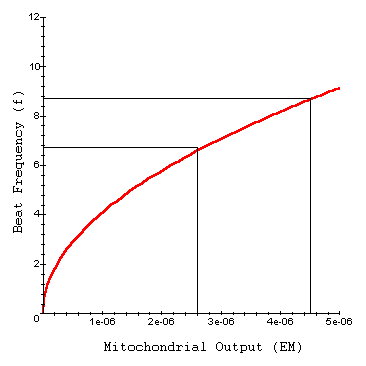
SPERM MOTILITY
Introduction: Mammalian sperm cells consist of a head, midpiece, and flagellum. The midpiece is densely packed with mitochondria. These mitochondria provide energy in the form of ATP to the flagellum to propel the cell.
Importance: Movement of the flagellum depends on properties of the sperm and surrounding medium. We can quantify expected flagellum movement and compare it to actual data to see how efficient mammalian sperm are using ATP.
Question: How can we quantify sperm movement? How efficient are mammalian sperm at converting ATP to flagellar movement?
Variables:
|
f |
beat frequency of flagellum (Hz) |
|
E |
production rate of energy from ATP per volume of mitochondria (ergs/(mm3 s) |
|
M |
mitochondrial volume (mm3) |
|
v |
viscosity of surrounding medium (poise) |
|
L |
length of flagellum (mm) |
|
p |
a constant |
Methods: The beat frequency (f) of the flagellum is directly related to the production rate of energy from ATP per volume of mitochondria (E) and the mitochondrial volume (M). It is inversely related to the viscosity of the surrounding medium (v) and the length of the flagellum. This relationship was expressed by Caruzzo and Baltz as

We can plot f as a function of the energy output of the mitochondria (EM) to determine how an increase in energy output affects beat frequency.

Interpretation: Beat frequency increases as mitochondrial output increases. However, the slope of this function becomes shallower as EM increases. In response to increased power, the beat frequency of sperm flagella also increased. However, due to the nature of this function, the resulting increase in movement is not very efficient. For example, if we increase EM by 70% we have a new value of 1.7 x EM. We can substitute this into the function f to determine the corresponding increase in beat frequency.

Therefore a 70% increase in power leads to only a 30% increase in beat frequency. Experimentally, in the presence of a metabolite, mitochondrial output increased approximately 72 % from 2.6x10-6 ergs/sec to 4.5x10-6 ergs/sec. The corresponding increase in beat frequency, however, was only about 19%.
Conclusions: Mammalian sperm movement is a function of mitochondrial output and sperm length. Experimental data and the equation of Cardullo and Baltz suggests mammalian sperm are inefficient at converting ATP to flagellar movement.
Source: Cardullo, R. A. and J. M. Baltz. 1991. Metabolic regulation in mammalian sperm: Mitochondrial volume determines sperm length and flagellar beat frequency. Cell Motility and the Cytoskeleton 19:180-188
Copyright 1999 M. Beals, L. Gross, S. Harrell